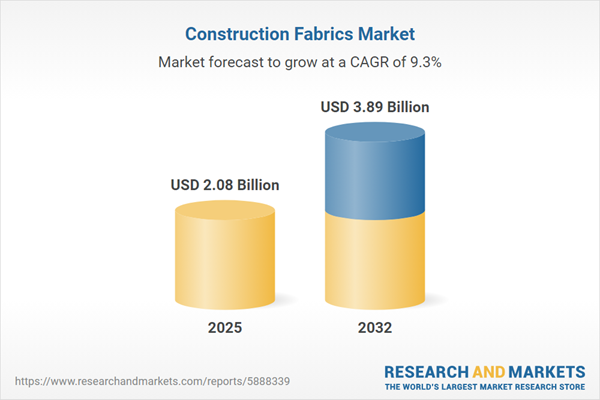Speak directly to the analyst to clarify any post sales queries you may have.
Senior decision-makers monitoring the construction fabrics market face an industry shaped by evolving regulations, heightened operational demands, and growing sustainability considerations. Understanding the market’s current trajectory helps organizations navigate risks and capitalize on new avenues for growth in a competitive environment.
Market Snapshot: Growth and Opportunities in the Construction Fabrics Market
The construction fabrics market continues to expand globally as advanced textiles become integral to modern architectural and infrastructure strategies. The sector, currently valued at USD 1.91 billion, is projected to achieve USD 3.89 billion by 2032 with a CAGR of 9.30%. This upward momentum reflects active investments in global urbanization, upgrades to aging structures, and the adoption of high-performance materials that align with changing compliance requirements. Digital technologies, smart construction materials, and adaptive manufacturing support organizations in meeting dynamic project needs while responding to client demands along the construction value chain.
Scope & Segmentation: Construction Fabrics Market Overview
- Product Types: Includes knit fabrics such as warp and weft, as well as non-woven options like meltblown, needle punch, spunbond, and spunlace. These solutions address a range of applications from extensive infrastructure projects to specialized architectural work.
- Material Types: Polyester, polyethylene, and polypropylene are selected for their resilience, adaptability, and ease of processing in diverse construction settings and climates.
- Applications: Utilization covers flooring, insulation, specialty roofing, protective barriers, and geotextiles. These materials support new constructions and retrofit initiatives, delivering robust and efficient performance.
- End Uses: Serves commercial, industrial, infrastructure, and residential segments. Construction fabrics are engineered to fulfill compliance, safety, and performance criteria specific to each segment’s requirements.
- Product Forms: Supplied in rolls and sheets to ensure flexible logistics and straightforward deployment across varying site scales and complexities.
- Coatings: Available both coated and uncoated. Optional finishes such as bitumen, polyurethane, or PVC provide additional durability and boost longevity in varied operational contexts.
- Distribution Channels: Products are accessed via direct sales, online platforms, and wholesale distributors. These channels ensure project leaders and end-users have consistent availability across key regions.
- Regions Covered: The market extends across the Americas, Europe, Middle East, Africa, and Asia-Pacific. Regional activity is strongly influenced by local regulations and market competition in China, India, Japan, Australia, and South Korea, highlighting varied growth dynamics and compliance challenges.
- Leading Companies Profiled: Market innovation is driven by companies including Koninklijke Ten Cate BV, NAUE GmbH & Co. KG, HUESKER Synthetic GmbH, Solmax International ULC, Sioen Industries NV, Berry Global, Inc., GSE Environmental, Inc., Colbond BV, Tenax S.p.A., and Propex Operating Company, LLC.
Key Takeaways: Strategic Insights for Senior Decision-Makers
- New fiber technologies, such as embedded sensors or self-repairing capabilities, are improving monitoring and lifecycle management for construction assets and infrastructure.
- Prioritizing responsible sourcing and ensuring traceable supply chains support compliance initiatives and promote achievement of sustainability benchmarks in sourcing and procurement.
- Manufacturers are integrating greater automation, including advanced weaving and in-line quality assessment, to enable customized solutions and more responsive production for tailored designs.
- Developing robust local and regional supply networks can help organizations avoid disruptions, improve logistical reliability, and ensure consistent project execution worldwide.
- Utilizing modular construction fabric systems allows rapid adaptation to evolving regulations or client demands, supporting agility as project requirements change.
Tariff Impact: Sourcing and Operational Adjustments
Recent adjustments in U.S. tariff policies prompt companies to reconsider supplier diversification and the feasibility of regional production. Strategic sourcing decisions and inventory control are essential for maintaining supply chain resilience and operational stability.
Methodology & Data Sources
Insights are based on executive interviews, consultations with technical specialists, patent analyses, and a proprietary review of sustainability programs. These sources combine to offer detailed, actionable guidance for senior leaders in planning and market positioning.
Why This Report Matters
- Provides strategic market intelligence and segmented insights to refine organizational direction, accelerate product development, and reduce exposure to compliance risks in global operations.
- Facilitates benchmarking and the application of sustainable procurement standards, supporting improved alignment with regional compliance frameworks and industry best practices.
- Empowers timely, data-driven decision-making in regulated and continuously evolving construction environments, enhancing competitiveness and preparedness.
Conclusion
Adapting to industry shifts in the construction fabrics sector depends on dynamic planning and reliable information. Aligning business objectives with emerging technology and regulatory priorities positions organizations to realize long-term opportunities.
Additional Product Information:
- Purchase of this report includes 1 year online access with quarterly updates.
- This report can be updated on request. Please contact our Customer Experience team using the Ask a Question widget on our website.
Table of Contents
3. Executive Summary
4. Market Overview
7. Cumulative Impact of Artificial Intelligence 2025
Companies Mentioned
The companies profiled in this Construction Fabrics market report include:- Koninklijke Ten Cate BV
- NAUE GmbH & Co. KG
- HUESKER Synthetic GmbH
- Solmax International ULC
- Sioen Industries NV
- Berry Global, Inc.
- GSE Environmental, Inc.
- Colbond BV
- Tenax S.p.A.
- Propex Operating Company, LLC
Table Information
| Report Attribute | Details |
|---|---|
| No. of Pages | 192 |
| Published | October 2025 |
| Forecast Period | 2025 - 2032 |
| Estimated Market Value ( USD | $ 2.08 Billion |
| Forecasted Market Value ( USD | $ 3.89 Billion |
| Compound Annual Growth Rate | 9.3% |
| Regions Covered | Global |
| No. of Companies Mentioned | 11 |









